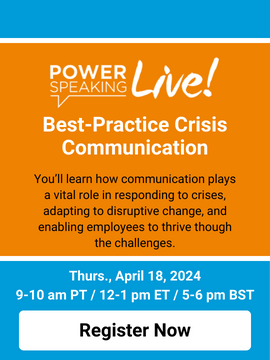
- Aug 21, 2023

Executive Presentations: How to Improve Presentation Skills
Executives are storytellers. They present recommendations, updates, and vision. They reveal new strategies with the expectation that people will take action and drive them forward. These messages must touch hearts and minds, or the listeners will not take action. That is why storytelling is necessary.
Effective executive presentations must be clear. They must be well-organized, concise, and delivered with confidence. Whether presenting to investors, board members, or employees, executive presentations play a critical role in shaping the future of the organization.

Executive Presentations
Executives who can deliver compelling presentations are better equipped to inspire and motivate their teams, build trust with investors, and make strategic decisions that drive business growth. Start with focusing on the 3 S's - Style, Structure, and Strategy.
Style includes starting with the right mindset, so you present as the best version of yourself. Believe that you have valuable information to share and the audience needs to hear it. Nonverbal cues also play a key role in establishing trust and connecting with your audience. Stand straight, sit upright, and keep a still frame to demonstrate physical poise. Support your message with intentional gestures like the karate chop, pincer, and open palm. Look directly at your listeners and hold eye contact for at least three to five seconds. Your voice is also critical to convey confidence. If you are mumbling, using filler words, or speaking too fast, you lose your audience. Project your voice to the most distant part of the room and take time to pause and allow your listeners hear every word you say.
Structure is important to make sure the most critical messages are heard and remembered. Begin with a governing thought and share only the most important information. Avoid the tendency to share too many details up front before getting to the headline. As an executive, your organization is looking to you to lead others through change. You can motivate and inspire an entire team by the way you tell stories. Make sure there is a hero and a villain. Clearly describe the situation, explain the challenge, and then pivot to a crescendo. Create a clear picture of the future so others know exactly where you want to go, how to get there, and what is expected of them.
Strategy ensures that you are positioning your information for acceptance. Include the right balance between positive and negative news. If you disagree, be diplomatic about it. Communicate early and often. Be willing to put a stake in the ground if others are looking to you to make the hard decisions.
Effective executive presentations can help establish credibility and build a positive reputation for both the individual and the organization they represent. By investing time in learning how to deliver impactful executive presentations, leaders can enhance their communication skills and elevate their performance in their roles.
Presentation Skills for Executives
When you go to prepare for a presentation, consider all aspects of what can make it great. Follow a checklist. Here are ten presentation skills that are critical for executives who must communicate complex ideas, strategies, and visions to diverse audiences.
1. Know your audience. What do they know, what do they need, what is their current opinion, and what do they want?
2. understand the purpose and objective, 3. connect with your listeners on a personal level, 4. engage the room with a strong start, 5. tailor the content and delivery to the audience, 6. build credibility and trust with your knowledge and expertise, 7. deliver a memorable message, 8. use visuals and other aids to support the message, 9. handle questions and challenges with ease, 10. be creative.
Investing in presentation skills coaching can help executives build confidence, communicate their vision and goals more effectively, and create meaningful connections with their stakeholders. By continuously honing their presentation skills, executives can elevate their performance and drive success in their organizations.
_________________________________________________________________________________
Developing communication skills is easy when you work with Speak by Design. We work with clients from around the world to help them master the art of public speaking and strengthen their presentation skills. We work with individuals, groups, and entire organizations. Schedule a call to discuss a program for your team or company.
For individuals, join us this September for our newest course on "Articulating a Vision". Enroll by August 31 .
- Effective Communication
- Presentations and Meetings
- Public Speaking
Recent Posts
Best Public Speakers Series: Arwa Damon
Best Public Speakers Series: Alli Webb
Best Public Speakers Series: Rabbi Angela Buchdahl
Moxie Institute
10 Tips For Impressive Presentations To Senior Leadership And Executives

10 PRESENTATION TIPS TO IMPRESS SENIOR LEADERS
Tip 1: prepare, tip 2: begin with the end in mind.
- What do you want this audience to feel when they’re done?
- What do you want them to know when you’re done?
- What do you want them to do, when you’re done?
TIP 3: BE CLEAR AND CONCISE
Tip 4: tell stories, tip 5: keep slides minimal.
Provide extra information in your slide notes
TIP 6: CHANNEL NERVOUS ENERGY INTO USABLE ENERGY
The best way to feel confident is to practice.
5 to 7 full rehearsals
TIP 7: PRE-PRESENTATION WARM UP
Breathe low and slow.
WARM UP YOUR BODY
Warm up your mouth, tip 8: have vocal executive presence, tip 9: commanding the space.
Presentation power posing
TIP 10: AUTHENTIC SPEAKER PERSONA
- Case Studies
- Communication Skills
- eBooks & Resources
- Leadership & Influence
- Conferences & Events
- Sales & Service
- Slide & Visual Design
- Storytelling & Speech Writing
- TED Talks & TEDx
- Testimonials
- Uncategorized
- Videos, Podcasts, & Webinars
- Virtual Communication

Presentation Design | The Ultimate Guide

Executive Presence Ultimate Guide

Overcoming Fear of Public Speaking Ultimate Guide

Interpersonal Communication Skills Ultimate Guide

Failing Forward: 5 Mindset Shifts To Bounce Back From An Awful Presentation

Public Speaking Tips to Improve Your Presentation Skills – Ultimate Guide
Sign up for weekly expert advice, free ebooks, & special offers.


- PowerSpeaking ® Get an Expert Foundation
- HighTechSpeaking ® Make Technical Data Come Alive
- Speaking Up: Presenting to Decision Makers ® Win Over Senior Executives
- SalesSpeaking ® Make the Sale
- ConferenceSpeaking™ Prepare for a Speaking Event
- Be Clear, Be Confident, Be Courageous Confident Speaking for Women
- Storytelling Course Tell Stories that Captivate
- Facilitation
- Facilitators
- Management & Staff
- Board Members
- Learning Hub
- PowerSpeaking Live!
Presentations
Communication, facilitation, powerspeaking blog: tips and strategies for crafting presentations, presenting to executives: 6 strategies for success.
by The PowerSpeaking Team Oct 24, 2023 7:48:59 AM

Senior executives have told us that 60% of the presentations made to them fail. Imagine the cost of that!
Innovative ideas that go nowhere because they weren’t presented persuasively. Projects that stall because a presenter didn’t drive a much-needed decision from the executive team. Or how about the cost of wasting corporate leaders’ time?
Why do so many people fail when pitching a new idea or asking for support for a new product, project, or resources?
Because most presenters, including people at the director level, don’t understand that pitching to senior decision makers requires a completely different strategy and skill set.
The good news is, we’ve unlocked the secrets to making more effective presentations to executives that help move the business forward.
Read on for invaluable, expert insights and advice . . .

Don't have time to read the whole guide right now?
Let us help you succeed with our guide on Presenting to Executives: 6 Strategies for Success . Get the PDF version that you can save to your desktop and read when it's convenient for you.
(Direct download. No form required)

Learn the Executive Mindset
Prepare for a Dialogue
Set the Context and Deliver Your Bottom Line
Make the business case, keep them engaged (even virtually), find and leverage a sponsor.
Executives are bottom-line-focused, strategic thinkers who want you to get to the point, step away from your slide deck, and be ready for a dynamic dialogue.
Seasoned executive Brent Kedierski elaborates on the executive mindset in this clip from a PowerSpeaking Live! panel discussion with CEO Carrie Beckstrom:
Next time you present to decision makers, remember they are:
🔹 T hinking in terms of the larger enterprise and business case
🔹 Pressured by many other decisions to make and requests to consider
🔹 Apt to become impatient if you aren’t concise and crystal clear
Few senior leaders are going to sit still for a one-way presentation from you, especially if you’re asking for their support or need a decision from them. So, plan for lots of interaction.
Be Prepared for a Dialogue
When planning your presentation, use the “10/30 Rule.” If you have 30 minutes on the executives’ meeting agenda, plan to present 10 minutes of material and devote the remainder of the time to discussion.

Remember that with decision makers, your role is to facilitate a conversation, not just deliver a presentation.
But speaking of your presentation, the first thing you should do is orient the leaders to the purpose of your time with them.
It’s important to remember that the executives will walk into that conference room with a million things on their minds. Your job is to first help them focus on why you’re there and what you need from them. Briefly .
Several executives we interviewed give some great insights on why and how to set the context for executives:
Monica Poindexter makes a great point in how setting the context is an opportunity for you and the executives to frame how the conversation will move forward.
Once you’ve set the context, it’s time to get to your main point—your bottom line—whether it’s a project update or a proposal. For example, what do you want the executives to say “yes” to?
Be specific. “I want your support” is vague. “I want you to approve a $500,000 investment in new centrifuge equipment this quarter” is specific.
Here are more senior leaders, explaining why it’s so important to lead with your bottom line:
Antares Audio Technologies’ Jeff Wright says it well: “An answer-first presentation is really what executives want.” In other words, why are they there and what do you want from them?
PowerSpeaking Master Facilitator and Coach David Binder tells a great story about a different executive presentation scenario, in which a group of would-be leaders failed to get to the main point with executives:
We love David’s point that presenters shouldn’t take a murder-mystery approach to their content!
And speaking of content, be sure to take a big-picture, business perspective when pitching an idea or request to decision makers.
If you’re asking for support or a decision from executives, state what value or ROI your ask will bring in terms of revenue increase, cost reduction, protection from risk, competitive advantage, or other business drivers. It can’t be just a “nice to have” proposal.
For example:
“We’re seeking your approval for 5 new FTEs in account management roles for an investment of $750,000. The reason is that we have a $2M revenue opportunity with the launch of [XYZ project]. These account managers will focus on the top 20% of our customer base to ensure we maximize the sales opportunity.”
Next, follow with the essential data—and do a deep dive only if asked.
Instead of drowning listeners in data, lead with the top 2-3 key points and evidence that best support your ask. The key points should be answers to the primary questions you think the executives will have about your proposal.
It’s important to “read the room” at all times to ensure the executives are engaged with your presentation and the dialogue associated with it.
Yet, reading the room can be especially challenging in virtual meetings.
CEO Carrie Beckstrom and PowerSpeaking Master Facilitator and Coach Payal Gandhi Hoon talk about what to do if you’ve lost your virtual audience:
We love Payal’s suggestion to re-engage an executive by making a comment or asking a question that keys off of something the executive said earlier. It’s a more personal, constructive way to draw them back in.
Finally, if you want to take your executive-presentation skills to the next level, find and leverage a sponsor.
Find someone who knows the group you’re presenting to, and who is willing to not only help you prepare as your guide, but also, advocate for you during the meeting.
Use your sponsor to: 1. Check the validity of your logic ahead of time 2. Rehearse with and get feedback 3. Agree on when you should look to them for help during the executive meeting
4. Debrief with your sponsor after the meeting to gain insights and lessons you can use in the future
Want more expert guidance on successfully presenting to and winning over senior decision makers? How to Present to Senior Executives (23 Proven Strategies) Here’s a sampling of the invaluable strategies you’ll learn:
- Consider executives’ personality styles
- Prepare for possible questions or objections
- Use the PREP model if your time gets cut
- Focus on analytical proof
- Be proactive and transparent when delivering unpleasant news
- Address feedback and challenging questions
- Acknowledge disagreements, but don't intervene

Join Us in Conversation . . .

Best-Practice Crisis Communication
Thursday, april 18, 2024, 9-10:00 a.m. pt/12-1:00 p.m. et/5-6:00 p.m. bst.

Curtis Kellogg
Strategic communications professional.
.png)
Staci Slaughter
Business & strategic communications advisor.

Nicole Wajer
Technical solutions architect, cisco.

Payal Gandhi Hoon
Master facilitator and coach, powerspeaking, inc..

Karen McDonagh Reynolds
Transformation director & board member, london market joint ventures, the powerspeaking team.
Topics: Leadership communication

Don’t Miss Out on Insights!
Subscribe to PowerSpeaking Insights to get our blog, best-practice tips, special offers, and more sent directly to your inbox.

Subscribe to PowerSpeaking Insights

Recent Posts
Popular posts.

Address: 1233 Harrison Avenue Redwood City, CA 94062
Fax: 650-631-8660-->
SUBSCRIBE TO POWERSPEAKING INSIGHTS
Get our blog, best-practice tips, special offers, and more sent directly to your inbox.
Copyright 2024 © PowerSpeaking, Inc. All rights reserved.
- Privacy Policy
- Cookie Policy
- SUGGESTED TOPICS
- The Magazine
- Newsletters
- Managing Yourself
- Managing Teams
- Work-life Balance
- The Big Idea
- Data & Visuals
- Reading Lists
- Case Selections
- HBR Learning
- Topic Feeds
- Account Settings
- Email Preferences
How to Give a Killer Presentation
- Chris Anderson

For more than 30 years, the TED conference series has presented enlightening talks that people enjoy watching. In this article, Anderson, TED’s curator, shares five keys to great presentations:
- Frame your story (figure out where to start and where to end).
- Plan your delivery (decide whether to memorize your speech word for word or develop bullet points and then rehearse it—over and over).
- Work on stage presence (but remember that your story matters more than how you stand or whether you’re visibly nervous).
- Plan the multimedia (whatever you do, don’t read from PowerPoint slides).
- Put it together (play to your strengths and be authentic).
According to Anderson, presentations rise or fall on the quality of the idea, the narrative, and the passion of the speaker. It’s about substance—not style. In fact, it’s fairly easy to “coach out” the problems in a talk, but there’s no way to “coach in” the basic story—the presenter has to have the raw material. So if your thinking is not there yet, he advises, decline that invitation to speak. Instead, keep working until you have an idea that’s worth sharing.
Lessons from TED
A little more than a year ago, on a trip to Nairobi, Kenya, some colleagues and I met a 12-year-old Masai boy named Richard Turere, who told us a fascinating story. His family raises livestock on the edge of a vast national park, and one of the biggest challenges is protecting the animals from lions—especially at night. Richard had noticed that placing lamps in a field didn’t deter lion attacks, but when he walked the field with a torch, the lions stayed away. From a young age, he’d been interested in electronics, teaching himself by, for example, taking apart his parents’ radio. He used that experience to devise a system of lights that would turn on and off in sequence—using solar panels, a car battery, and a motorcycle indicator box—and thereby create a sense of movement that he hoped would scare off the lions. He installed the lights, and the lions stopped attacking. Soon villages elsewhere in Kenya began installing Richard’s “lion lights.”
- CA Chris Anderson is the curator of TED.
Partner Center
📞 Call Now 800.403.6598 Contact Us - Get Started

No products in the cart.
World-Class Training
Overcome Your Fear. Stand Out. Get Noticed. Be Heard!

Effective Presentations – Presentation Skills and Public Speaking Training
Effective Presentations offers results-driven training programs proven to provide you with the skills you need to comfortably present your thoughts and ideas with confidence, competence, and clarity .

Training for Myself
Master the art of persuasive presentations and unleash your full potential as a communicator. Elevate your career by acquiring effective presentation skills that captivate any audience, convey ideas with clarity and confidence, and leave a lasting impact.
Enhance your professional image, boost your influence, and propel your success. Enroll in one of our effective workshops today and unlock the power of impactful communication. Catapult your career today.

Training for My Team
Launch your team’s success with our specialized effective presentations skills. Equip your team with the tools they need to deliver compelling and impactful presentations. Present with confidence and learn how to craft persuasive messages.
Our workshops offer practical techniques tailored to your team’s unique needs. Watch as their professional image soars, collaboration strengthens, and client interactions reach new heights. Invest in their growth and watch your organization shine.
― Upcoming Workshops
In-person training.
Live public speaking courses at a location near you, that will immediately accelerate your success!

Our Workshops

Business Presentations
Your team will confidently deliver winning presentations with competence and clarity.

Presentation Skills
Master vital verbal and non-verbal techniques you need to captivate your audience.

Experience hands-on, Effective Presentations from anywhere in the world.

Messaging & Structure
Go from simply being capable and confident enough to speak to being an expert communicator.

Keynote Speakers
Ignite your next corporate event with a motivational speech to boost your team

Learn about your own leadership style and how to magnify your natural strengths.

Executive Coaching
Elevate your communication with One-on-One coaching tailored to your specific goals.

Sales Training
Fundamental elements of professional selling are within your reach.
Job Promotions
Bold Presenters
Fears Overcome
Lives Saved
(Death By PowerPoint)
― Testimonials
What Our Clients Are Saying About Us

Essential Skills for That Executive Presence
Tap into the power of effective presentation skills and cultivate an executive presence that commands attention. In today’s competitive business landscape, the ability to captivate, persuade, and inspire is non-negotiable.
Our comprehensive courses will empower you with the tools to confidently convey your message, exude charisma, and leave a lasting impact.
Elevate your leadership potential, unlock career opportunities, and gain a competitive edge. Invest in yourself and enroll in our transformative program today. Discover the leader within and watch your professional success soar to new heights.

Effective Presentation Skills For Your Business
Presentation skills are the primary tool of your business. You must master verbal and nonverbal communication to make positive first impressions with customers and colleagues.
The best salespeople know how to close a sale, but even they can benefit from presentation skills and workshops.
Learn insights into what makes a presentation effective and explores essential techniques for improving your communication skills. As an established small-group learning provider, we offer expert coaching in a safe, non-judgmental environment.
- General Presentation Skills
- Executive Presentation Skills
- Technical Presentation Skills
- Presenting to Executives Skills
- New Manager Communication Skills
- Leadership Communication Skills
- Customer Service Excellence
- Emotional Intelligence in Customer Service
- Public Sector Customer Service
- Front Desk Service Training
- Health Care Customer Service
- Automotive Customer Service
- Law Firm Customer Service Workshop
- Library Customer Service
- Effective Communication in a Matrixed Environment
- Dealing with Difficult People
- How to Write Effective Emails
- Inclusion & Workplace Diversity
- IT Communication
- Meeting Facilitation
- Personal Brand Communication
- Persuasive Communication
- Resiliency and Change Management
- Time Management Training
- Virtual Communication
- Training from the Back of the Room
- Training from the Back of the Room Virtual Edition
- Results Coach
- Public Speaking Coach
- Virtual Presentation Coach
- Member Login

Presentation Skills Workshops
Presenting to executives with confidence, become a masterful presenter.

Are you ready to unlock a world of opportunities and elevate your career to new heights? We have designed our highly interactive and transformative Presenting to Executives Workshop to equip you with the skills and knowledge to become a masterful presenter when presenting to the C-Suite.
Contact Laurie now at (248) 761-7510 for Presenting to Executives with Confidence Training.
Learning Outcomes
Why should you take a workshop on Presenting to Executives with Confidence? Here are some of the benefits you will experience:
- Influence and Inspire: Imagine having the power to sway executive decisions and inspire action. With our training, you'll gain the ability to craft compelling presentations that captivate executives, making you an influential force within your organization.
- Career Advancement: Effective executive presentations are a catalyst for career growth. By mastering the art of presenting, you'll stand out from the crowd and gain recognition for your exceptional communication and leadership skills. Prepare to embrace new opportunities and reach unprecedented professional milestones.
- Enhanced Credibility: As you become proficient in delivering executive presentations, your credibility will soar. Executives will recognize you as a trusted advisor who can distill complex information into clear, concise messages. Gain their trust and become a go-to resource in your field.
- Impactful Project Success: Presentations to executives are pivotal moments for project success. Our training empowers you to craft presentations that resonate with executives, ensuring they fully grasp the value and significance of your initiatives. Secure the resources, support, and decisions needed for project triumph.
- Unleash Your Confidence: Our workshop not only equips you with presentation skills but also instills unwavering confidence. Step into any executive setting with poise, assured in your ability to deliver a powerful and engaging presentation. Witness how your newfound confidence permeates other aspects of your professional life.
We will customize this program or coaching session to address your wants and needs.
Transformative Outcomes:
Understand the Elements of a Good Executive Presentation: Discover the key components that make executive presentations impactful and compelling, ensuring you leave a lasting impression.
Cater to Executive Expectations: Learn to identify and address what each leader wants to hear, tailoring your presentations to meet their specific needs and interests.
Create Impactful Presentations: Master the art of structuring and organizing your presentation to create maximum impact, leaving executives impressed and engaged.
Harness Brain Science in PowerPoint Presentations: Design visually stunning and brain science-based PowerPoint presentations that captivate attention and enhance comprehension.
Handle Pushback with Confidence: Develop strategies to confidently handle pushback or objections from executives, turning challenges into opportunities to strengthen your presentation further.
Navigate Questions with Ease: Learn effective techniques for answering questions from executives with clarity, confidence, and poise.
Maximize Non-Verbal Impact: Understand how body language and tone of voice impact your credibility and executive presence. Harness these powerful tools to enhance your message delivery.
Practice and Feedback: Engage in practical exercises that allow you to implement your newfound skills. Receive valuable feedback from our experienced trainers, enabling you to refine and perfect your executive presentation skills.
Join our Communication Skills Training workshop and embark on a transformative journey that will elevate your executive presentation skills to unprecedented heights. Unlock the doors to career advancement, influence, and success. Don't wait—start your transformation now.
Contact Laurie now at (248) 761-7510 for Presentations Skills for Executives Training.
" Laurie has been a great coach and tremendous help in improving the quality of my presentations. The use of practice sessions / video tools as well as current best practice training were well balanced and supported the learning process. Her openness and honesty as well as willingness to assist in many complementary areas (effective video / teleconferencing, tone, posture, stress management etc.) made her a real pleasure to work with. She has made herself available to support and provide feedback on day-to-day issues/questions during our time together. I fully recommend and endorse her services. "
—JOE DIZAZZO, Regional Chief Executive, Latin America Crafts at Coats
Sign Up for a Free Presentation Skills Newsletter…

… and get this Free Technical Presentation Skills White Paper!
- First Name* *
- Last Name *
More From Forbes
Mastering executive presence: the critical leadership competence for today's business landscape.
- Share to Facebook
- Share to Twitter
- Share to Linkedin
Jon Michail is Founder & Group CEO of Image Group International & best-selling author of Life Branding. Follow him on LinkedIn & Twitter.
In the modern business environment, having an executive presence is not merely a bonus requirement for leaders. Executive presence plays an important role in instilling confidence, earning respect and assisting organizations toward success. As a top executive or leader today, you’ll be faced with unique challenges and obstacles where possessing an executive presence will make all the difference. It shouldn’t come as a surprise that to be considered for senior roles, the existence or lack of executive presence is a major deciding factor.
However, there’s been a massive shift in what executive presence means today and what it used to mean back in the day. This is why discussing and understanding the meaning and significance of executive presence in this modern time is important.
The Evolution Of Executive Presence
Executive presence has always been regarded as an important attribute. Still, in the past, it was mostly about dressing and looking superior, radiating confidence and giving firm handshakes. This is no longer the case today; having an executive presence now encompasses a whole lot more, especially as the workplace and professional culture evolve.
Coqual conducted research that sheds more light on this new reality. According to this research, aside from having the traditional strong physical presence, executive presence is a combination of different attributes, which include gravitas and exceptional communication skills. Remarkably, it should be noted that the most significant factor of all is no longer the commanding physical presence, but gravitas, which was found to have a 67% influence in determining how effective people perceive a leader to be.
Is Leadership an Art or a Science
Gmail and youtube hackers bypass google’s 2fa account security, apple confirms innovative iphone 16 pro upgrade, the impact and elements of executive presence.
Just from the term “executive presence," it’s easy to see that any leader with this trait will stand out from other leaders. Possessing this attribute goes beyond the skills or professional experience one has as a leader. It’s all about sending the right signals, and more often than not, that can determine how successful a person becomes in their professional career.
The impact of executive presence is also recognized by professionals, as evidenced in a Gartner CIO survey, where it was ranked as the second most important trait for leaders who make a difference. It’s already clear that having an executive presence is nonnegotiable if leaders want to go far professionally, but what exactly are the traits to nurture? And more importantly, why are these traits crucial?
Gravitas As The Core
As already mentioned, gravitas is the most important attribute for anyone who can be said to possess executive presence. Gravitas simply means exuding confidence, self-assurance and decisiveness when under pressure. With this trait, such leaders are often found to be reliable and competent in difficult times.
Jeff Bezos, CEO of Amazon, showed his understanding of this when he was quoted saying, “If you're not stubborn, you'll give up on experiments too soon. And if you're not flexible, you'll pound your head against the wall, and you won't see a different solution to a problem you're trying to solve." This quote encapsulates the importance of confidence and resilience to stick to a vision as well as the emotional intelligence to be flexible, which are the essence of gravitas. Striking a balance here can very well make all the difference if leaders are to achieve success and remain relevant in a constantly changing professional environment.
Communication: Taking Command And Articulating Vision
Another important attribute to cultivate is the ability to communicate efficiently. Communication does not stop at the verbal aspect; it includes non-verbal aspects like the ability to read an audience and take control. Without communication, it’s almost impossible for anyone else to genuinely buy into your vision , not to mention work toward the end goal.
A brilliant example of someone who understands the power of genuine communication is Oprah Winfrey. She understands that a leader can only build relationships and motivate their team with the right kind of communication. In Oprah’s own words , “Great communication begins with connection. What makes us different from one another is so much less important than what makes us alike—we all long for acceptance and significance. When we recognize those needs in ourselves, we can better understand them in others, and that's when we can set aside our judgments and just hear."
Blending Appearance With Values
Your image influences first impressions, and first impressions matter a lot more than many people think. If image did not matter, the president of the United States would present onstage in shorts and T-shirts, looking very relaxed but lacking gravitas. The way you appear as a leader still does and always will have a significant impact. In fact, this importance is especially pronounced if you’re yet to make a name for yourself or make an impact as a leader.
Your appearance should be in line with the personal and organizational values you wish to portray. When you need to meet stakeholders, a good "presentation" is important and should be in line with or exceed their expectations. Authentic presence is not about copying colleagues, it’s about presenting "brand you"—a comfortable, confident and impactful leader. Remember, your look "speaks" before you open your mouth.
Cultivating Executive Presence In The Digital Age
As we live in a digitally driven society, technology is a major part of our existence, influencing our interactions with others. Thus, the savvy leader also understands the importance of leveraging social media to augment their visibility while engaging stakeholders. However, to be successful, it should be done with authenticity, so your values and beliefs are accurately reflected in your online presence. When executed correctly, not only can leaders significantly improve their executive presence, but they can also build trust, loyalty and meaningful relationships with their audience.
Consider executive presence as the “magnetic” cover of a book. A magnetic presence opens doors like nothing else, and a smart leader knows that it takes a “total package” to succeed!
Forbes Coaches Council is an invitation-only community for leading business and career coaches. Do I qualify?

- Editorial Standards
- Reprints & Permissions

IMAGES
VIDEO
COMMENTS
Save. Buy Copies. Senior executives are one of the toughest crowds you'll face as a presenter. They're incredibly impatient because their schedules are jam-packed — and they have to make ...
Here are a few tips for business professionals who want to move from being good speakers to great ones: be concise (the fewer words, the better); never use bullet points (photos and images paired ...
HBR Learning's online leadership training helps you hone your skills with courses like Presentation Skills. Earn badges to share on LinkedIn and your resume. Access more than 40 courses trusted ...
Tip 1 Understand the executive mindset. Tip 2 Consider executives' personality styles. Tip 3 Give yourself enough time to gather data. Tip 4 Find and leverage a sponsor. Tip 5 Prepare for possible questions or objections. Tip 6 Follow the 10/30 Rule. Tip 7 Set the context and confirm the time slot.
Here are five tips to help you give a successful executive presentation: 1. Be as concise and succinct as possible. When giving an executive presentation, it's important to be as concise as possible. This is because C-level executives may have packed schedules full of similar meetings, meaning they may have little time to offer you during your ...
1. Visual presentation style. The visual style is one of the most popular -- both in PowerPoint and other styles of presentation. They tend to be very dependent on images and video, often, with complementary audio. The tech industry does this all the time, with Apple among the most notable users of the style. 2.
Designing an Effective Executive Presentation in PowerPoint. Creating an executive presentation for C-level executives is a valuable opportunity to impact your organization significantly. When ...
Effective executive presentations must be clear. They must be well-organized, concise, and delivered with confidence. Whether presenting to investors, board members, or employees, executive presentations play a critical role in shaping the future of the organization.
4. Choose Visuals Consciously. If you really want to craft an outstanding executive presentation, include visuals not to make your slides look cool, but to support your information and make it more meaningful. Use images, graphics, tables, and charts wherever required to convey your message with less text.
12 strategies for presenting to executives. Here are 12 strategies for presenting to executives in the most professional manner possible: 1. Take time to prepare. It's essential to thoroughly prepare before speaking to an executive audience as it can be challenging to obtain a similar opportunity in the future.
Presenting to high-level executives comes with unique challenges—and, often, heightened nerves. Discover the keys to delivering effective presentations to a C-suite audience.
15+ Tips for Better Executive Presentations (+ Expert Advice) PowerPoint executive presentation templates such as those found on Envato Elements give your executive presentation a professional edge. Are you planning on presenting recommendations to senior management? Use the following tips to create more effective executive presentations: 1.
TIP 4: TELL STORIES. Number 4 is to tell stories and give examples. Bring the data to life. I love the quote by Brene Brown which is "Stories are just data with a soul.". I know a lot of us have data-heavy presentations. Bring them to life by telling stories. I'll give you another example.
Lastly, leave ample time for discussion. Follow the 10/30 rule: if you have 30 minutes on the agenda, plan for 10 minutes of content and earmark the rest for interaction. Anticipate questions ...
A strong presentation is so much more than information pasted onto a series of slides with fancy backgrounds. Whether you're pitching an idea, reporting market research, or sharing something ...
The good news is, we've unlocked the secrets to making more effective presentations to executives that help move the business forward. Read on for invaluable, expert insights and advice . . . ... PowerSpeaking Master Facilitator and Coach David Binder tells a great story about a different executive presentation scenario, in which a group of ...
1. Start with the bottom line. We don't want to search for your ask, call to action, solution or recommendation. 2. Respect our time. Get to the point quickly. Don't assume that our invitation to present and our willingness to listen includes an invitation to talk about other topics of importance to you. 3.
Presentation skills are the abilities and qualities necessary for creating and delivering a compelling presentation that effectively communicates information and ideas. They encompass what you say, how you structure it, and the materials you include to support what you say, such as slides, videos, or images. You'll make presentations at various ...
Step 1 - Know your audience and Step 2 - Know your purpose • 6 minutes. Step 3 - Structure the body of your presentation • 7 minutes. Step 4 - Plan how you will start your presentation • 3 minutes. Step 5 - Plan how you will end your presentation • 2 minutes. Step 6 - Prepare your visual aids • 3 minutes.
Effective Executive Speaking. Take your public speaking to the next level! Speak, present and communicate with poise, power and persuasion. From presentations to public speeches, your effectiveness as an executive and future career hinge on your ability to step up to the podium, command attention and transform every presentation into a credible and compelling communication.
To create excellent executive presentations, you need to understand the 4 executive thinking styles. Then you need to tailor your message to appeal to those thinking styles instead of your own The four thinking styles of executives is an adaptation of Dr. Bernice McCarthy's 4MAT learning style system developed for to enhance the educational ...
Frame your story (figure out where to start and where to end). Plan your delivery (decide whether to memorize your speech word for word or develop bullet points and then rehearse it—over and ...
Elevate your career by acquiring effective presentation skills that captivate any audience, convey ideas with clarity and confidence, and leave a lasting impact. Enhance your professional image, boost your influence, and propel your success. Enroll in one of our effective workshops today and unlock the power of impactful communication.
Career Advancement: Effective executive presentations are a catalyst for career growth. By mastering the art of presenting, you'll stand out from the crowd and gain recognition for your exceptional communication and leadership skills. Prepare to embrace new opportunities and reach unprecedented professional milestones.
Executive presence has always been regarded as an important attribute. Still, in the past, it was mostly about dressing and looking superior, radiating confidence and giving firm handshakes.
2 1 2 executive office of the president office of management and budget washington, d.c. 20503 . the director . april 4, 2024 . m-24-11 . memorandum for heads of executive departments and agencies